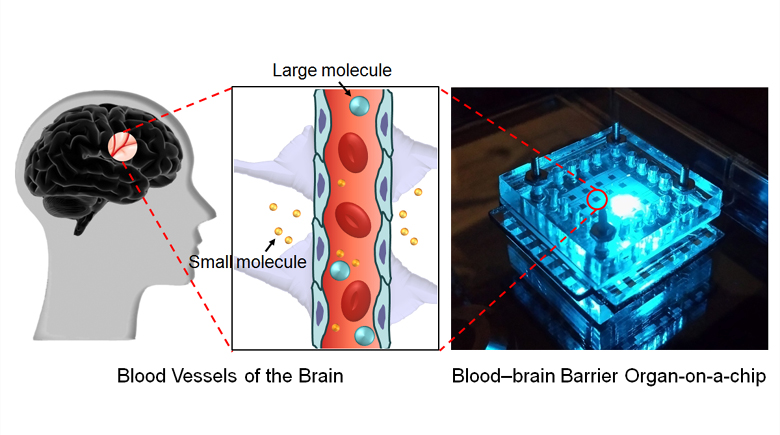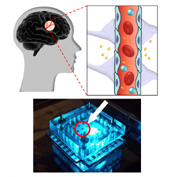 The blood–brain barrier (BBB) poses a unique challenge to the development of therapeutics against neurological disorders due to its impermeability to most chemical compounds. Most in vitro BBB models have limitations in mimicking in vivo conditions and functions. Here we show a co-culture microfluidic BBB-on-a-chip that provides interactions between neurovascular endothelial cells and neuronal cells across a porous polycarbonate membrane, which better mimics the in vivo conditions, as well as allow in vivo-level shear stress to be applied. A 4×4 intersecting microchannel array forms 16 BBB sites on a chip, with a multi-electrode array integrated, which allows label-free real-time analysis of the barrier function. Primary mouse endothelial cells and primary astrocytes were co-cultured in the chip while applying in vivo level shear stress. Co-culture between astrocytes and endothelial cells, as well as in vivo level shear stress applied, led to the formation of tighter junctions and significantly lower barrier permeability. Moreover, drug testing with histamine showed increased permeability when using only endothelial cells compared to almost no change when using co-culture. Results show that the developed BBB chip more closely mimics the in vivo BBB environment. The developed multi-site BBB chip is expected to be used for screening drug by more accurately predicting their permeability through BBB as well as their toxicity.
The blood–brain barrier (BBB) poses a unique challenge to the development of therapeutics against neurological disorders due to its impermeability to most chemical compounds. Most in vitro BBB models have limitations in mimicking in vivo conditions and functions. Here we show a co-culture microfluidic BBB-on-a-chip that provides interactions between neurovascular endothelial cells and neuronal cells across a porous polycarbonate membrane, which better mimics the in vivo conditions, as well as allow in vivo-level shear stress to be applied. A 4×4 intersecting microchannel array forms 16 BBB sites on a chip, with a multi-electrode array integrated, which allows label-free real-time analysis of the barrier function. Primary mouse endothelial cells and primary astrocytes were co-cultured in the chip while applying in vivo level shear stress. Co-culture between astrocytes and endothelial cells, as well as in vivo level shear stress applied, led to the formation of tighter junctions and significantly lower barrier permeability. Moreover, drug testing with histamine showed increased permeability when using only endothelial cells compared to almost no change when using co-culture. Results show that the developed BBB chip more closely mimics the in vivo BBB environment. The developed multi-site BBB chip is expected to be used for screening drug by more accurately predicting their permeability through BBB as well as their toxicity.

